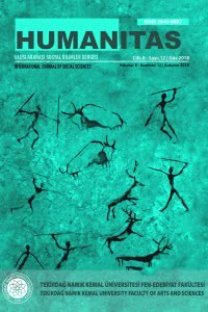ULUSU SAYFAYA TAŞIMAK: RAJA RAO’NUN KANTHAPURA ADLI ESERİNDE ULUS TAHAYYÜLÜ
Raja Rao’nun Kanthapura adlı eseri, Gandhi’ye ait fikirlerin ve ideolojinin Kanthapura adlı köye ulaşması ve buradaki yaşam üzerinde yarattığı kapsamlı değişime yoğunlaşmaktadır. Rao’nun köyü merkeze koyan ulusal kimlik betimlemesi, İngiliz sömürgeciliğine karşı ortak bir tarih ve kolektif aidiyet bilinci yaratma amacıyla yüzyıllara dayanan Hint kültürü ve geleneklerinin kullanılmasını temel almaktadır. Romanda, kolonyal baskıyla mücadele etme ve yeni bir toplum tahayyül etme gücü arayan köylüler, ortak kültürel ve dini geçmişlerini yeniden keşfederler. Böylelikle anlatının gelecekteki topluma dair tahayyülü geçmiş odaklı bir yol izler ve geçmiş, şimdi ve geleceği köy mikrokosmosunda bir araya getirir. Bu çalışma, tahayyül edilen ulus fikrine ait zamansal kaynağın ulus ve gelecekteki toplum fikrinin oluşumundaki olanak ve kısıtlamaları belirlediğini ileri sürmektedir.
Anahtar Kelimeler:
Postkolonyal Edebiyat, Hindistan, Ulusal Kültür, Raja Rao, Kanthapura
CREATING THE NATION ON THE PAGE: THE IMAGINED NATIONHOOD IN RAJA RAO’S KANTHAPURA
Raja Rao’s Kanthapura (1938) focuses on the story of how Gandhian ideology reaches the village of Kanthapura and changes the villagers’ lives drastically. Rao’s portrayal of national identity, by putting the village in the center, relies heavily on the use of centuries-old Indian culture and traditions in order to create a sense of shared history and collective sense of belonging against British colonialism. In the novel, the villagers re-discover their shared cultural and religious past in their attempt to find the strength to fight against colonial domination and envision a new society. Thus, the narrative’s imagining of the future society follows a past-oriented trajectory, namely combining the past, present and future in the microcosmos of the village. I contend that the temporal origin of the projected nationhood determines the limitations and possibilities for the formation of the idea of nation and the future society.
Keywords:
Postcolonial literature, India, national culture, Raja Rao, Kanthapura,
___
- Anderson, B. (2006). Imagined communities: Reflections on the origin and spread of nationalism. New York: Verso.
- Chatterjee, M. (2000). Khadi: The fabric of the nation. New Literature Review, 36, 105-113.
- Chatterjee, P. (1993). The nation and its fragments: Colonial and postcolonial histories. Princeton: Princeton University Press.
- Gopal, P. (2009). The Indian English novel: Nation, history, and narration. Oxford: Oxford University Press.
- Jain, J. (2007). A phoenix called resistance. Journal of Postcolonial Writing, 43(2), 172-182.
- Khair, T. (2001). Babu fictions: Alienation in contemporary Indian English novels. New York: Oxford University Press.
- Lazarus, N. (2011). The postcolonial unconscious. New York: Cambridge University Press.
- McLeod, J. (2013). Postcolonialism and literature. In G. Huggan (Ed.), The Oxford handbook of postcolonial studies (p. 449-467). New York: Oxford University Press.
- Mohan, A. (2012). Utopia and the village in South Asian literatures. New York: Palgrave MacMillan.
- Mondal, A. (2002). The emblematics of gender and sexuality in Indian nationalist discourse. Modern Asian Studies, 36(4), 913-936.
- Monti, A. (2001). A plea and a cheer for Indian English: A note on Raja Rao. In R. Mittapalli and Piciucco, P.P. (Eds.) The fiction of Raja Rao: Critical studies (p. 53-61). New Delhi: Atlantic Publishers and Distributors.
- Moorty, S.S. (1996). Narrative technique in Raja Rao’s Kanthapura. Commonwealth, 19(1), 111-15.
- Nair, M. K. (1982). Raja Rao. Calcutta: Blackie and Son Publishers.
- Prasad, G. J. V. (2011). Writing India, writing English: Literature, language, location. New York: Routledge.
- Rao, R. (1963). Kanthapura. New York: New Directions.
- Sethi, R. (1996). Contesting identities: Involvement and resistance of women in the Indian national movement. Journal of Gender Studies, 5(3), 305-315.
- Sethi, R. (1999). Myths of nation: national identity and literary representation. Oxford: Clarendon Press.
- Shingavi, S. (2013). The Mahatma misunderstood: The politics and forms of literary nationalism in India. New York: Anthem Press.
- Srivastava, N. (2010). Towards a critique of colonial violence: Fanon, Gandhi and the restoration of agency. Journal of Postcolonial Writing, 46(3-4), 303-319.
- ISSN: 2147-088X
- Yayın Aralığı: Yılda 2 Sayı
- Başlangıç: 2013
- Yayıncı: Namık Kemal Üniversitesi
Sayıdaki Diğer Makaleler
RUMELİ DEMİRYOLLARI EGE DENİZİ BAĞLANTI HATTINDA YENİ BİR LİMAN KENTİ: DEDEAĞAÇ (1872-1912)
PATRICK MCCABE’İN THE BUTCHER BOY ADLI ROMANINDA KÖTÜCÜL NOSTALJİ
KEDERLİ VE KEDERLİ OLMAYAN YAŞAMLAR: PHIL KLAY’IN REORGANİZASYONU
ÇOCUK ŞİİRLERİNDE SORU, SORGULAMA VE FELSEFİ DÜŞÜNME: MUSTAFA RUHİ ŞİRİN ÖRNEKLEMİ
ERDEMLE İLGİSİNDE MİLL’İN FAYDACI AHLAK ANLAYIŞININ ELEŞTİRİSİ
JOHN FISKE VE POPÜLER KÜLTÜR: MARGARET TYLER’IN “OKUYUCUYA MEKTUP”UNUN ELEŞTİREL BİR OKUMASI
BATILAŞMA DÖNEMİNDE İSTANBUL’DA RUM CEMAATİNİN EĞİTİMİ
ULUSU SAYFAYA TAŞIMAK: RAJA RAO’NUN KANTHAPURA ADLI ESERİNDE ULUS TAHAYYÜLÜ
